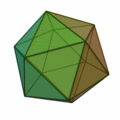Icosahedral group

The icosahedron group is the point group of the homogeneous icosahedron (and the homogeneous dodecahedron , which is dual to the icosahedron). It consists of the rotations and reflections that the icosahedron transforms into itself and is of order 120. It is too isomorphic, whereby the alternating group is of order 5 (group of even permutations of 5 objects) and the cyclic group is of order 2 (consisting of the identity and the space reflection at the center of the icosahedron).
The subgroup that is too isomorphic, the icosahedron rotation group, consists of the orientation-maintaining symmetries of motion of the icosahedron (rotations). You can use this rotating group z. B. can be realized as a group of even permutations of the five cubes inscribed in a regular dodecahedron. is the smallest simple non-commutative group and has order 60.
The icosahedral group contains five-fold rotations and is therefore incompatible with long-range crystalline order ( see space group ). Quasicrystals , on the other hand, often have icosahedral symmetry.
The character table of the icosahedron group contains the golden ratio and related numbers, which is a direct consequence of the fivefold rotational symmetry.
Since the soccer ball is derived from a truncated icosahedron , it also has the icosahedron group as a symmetry group, as does the “soccer molecule” C 60 (buckyball).
The icosahedron group has diverse applications in mathematics, which are presented in Felix Klein's classical work, lectures on the icosahedron and the solution of the equations of the fifth degree . According to Galois theory, the general equation of the fifth degree has no solution in radicals, since it is not solvable (it is a finite simple group ).
In crystallography , the rotation group of the icosahedron is designated with the Schoenfliess symbol and the complete symmetry group with .
Web links
- Icosahedral Group, Mathworld
- JH Eschenburg The icosahedron and the fifth degree equation according to Felix Klein , pdf
Individual evidence
- ^ New edition by Peter Slodowy , Birkhäuser 1993, originally Leipzig, Teubner 1884, online
- ↑ Slodowy The Icosahedron and the Fifth Degree Equation , Mathematische Miniatures 3, Birkhäuser 1986





